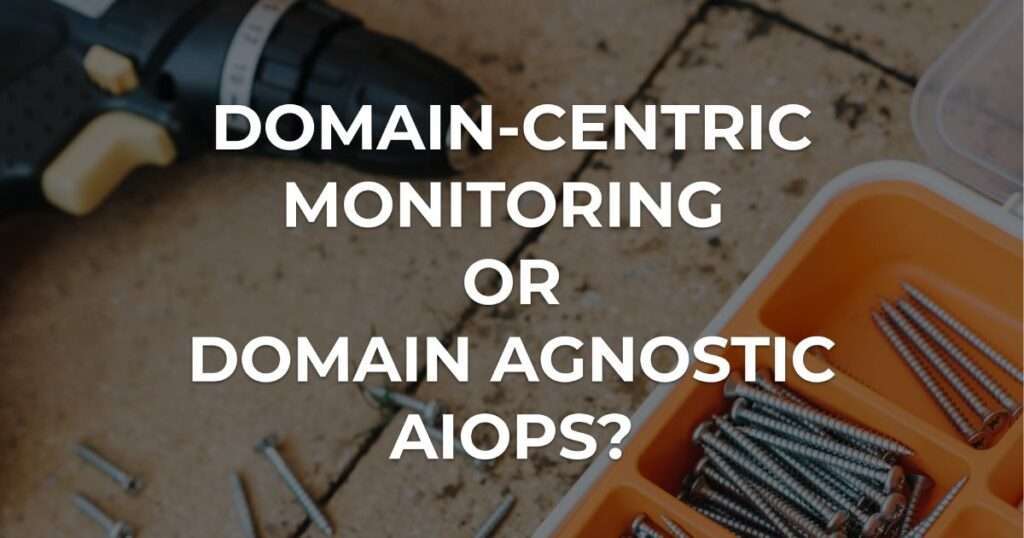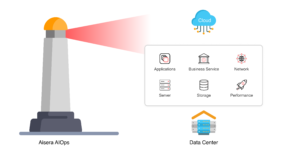Domain-Centric Monitoring or Domain-Agnostic AIOps?
When building the next-generation enterprise of the future to push the limits of what was previously thought to be nothing short of impossible, companies are adopting the latest and greatest cutting-edge technologies including AIOps on their mission to create a product far greater than the sum of its parts.
In decades past, these technologies took the form of monolithic architecture–and with it, the reliance on a single vendor to solve every solution and cover every use case for the company.

Yet these monolithic solutions did not cover every use case the client encountered, let alone every use case they needed to solve. As enterprises began voting with their wallets to spur competition and more tech companies began to bring their solutions to market, innovations began to be snapped up by more and more consumers looking to stay ahead of the curve.
Shine a Little Light
It is no mystery that the most recent evolution of this technological arms race has been the ubiquity of SaaS solutions, AIOps platforms, and microservices. The very DNA of businesses from Mom-and-Pop shops to Fortune 500 companies is composed of an ocean of microservices, with a greater shift to the cloud.
It should come as no surprise that with so many different applications serving their independent function, aided by AIOps in monitoring and analyzing data, it is still incomprehensibly difficult to find out when something goes wrong – a real needle in the haystack situation.
There have been a variety of tools that have been created to solve these IT operations and software development issues. Still, they have mostly been point solutions that merely monitor a handful of applications and ring a bell when things are already heading south. These domain-centric monitoring solutions have undergone quite a bit of innovation themselves and are by no means old-fashioned. However, there is another kind of solution.

A lighthouse, shining through the impenetrable shroud of a fierce Nor’easter: Domain-Agnostic AIOps.
The Right Tool for the Job
A disruptive new technology, AIOps, harnesses AI and machine learning, natural language processing (NLP), automation, predictive analytics, and collaboration tools to aggregate and analyze immense volumes of alerts, incidents, change data, problems, and tickets collected in real-time from a wide variety of sources across the entire IT infrastructure, from physical to virtual, in a data center or the cloud. To frame it using another analogy, domain-centric monitoring tools are screwdrivers, and domain-agnostic AIOps solutions are power drills.
Screwdrivers are uncomplicated and have withstood the test of time. But just because a screwdriver is “simple” does not mean it is ineffective! Where people run into some issues with screwdrivers is that one must have the right head (Phillips, flathead, etc.) and a considerable amount of time and elbow grease to get the job done.
In comparison, a power drill has every attachment imaginable and can likely complete the same job much faster. It can be used as a screwdriver, a drill, a buffing wheel, an auger, a scrub brush, a nut driver, and many other things. However, something to consider is that power drills are heavier and need to be maintained. So you may be asking yourself, “Which is better, the modular power drill or the humble screwdriver”?
The answer to this question is a resounding “it depends.” The reason for this answer is that both can be immensely effective when it comes to keeping tabs on your tech stack. Point-source monitoring solutions are better suited to maintaining a pulse on critical pieces of your infrastructure and quickly alerting IT Ops teams when something is not working correctly. These tools have been time-tested and widely used because they are adept at monitoring a handful of applications in a given domain with ease. On the other hand, IT teams lose the larger perspective because point-solutions do not correlate across data sources, whereas AIOps solutions can. And, like any seasoned craftsman, companies should not consider one tool as superior to the other, but that each has a time and place, and that these tools can work together.
A Journey Worth Taking
Like with digital transformation moving from on-prem to cloud, implementing domain-agnostic AIOps is a journey. Enterprises can’t merely shut off the old solutions. There needs to be a transition to the new solution, with many AIOps options sitting on top of existing domain-centric tools and integrating them as a data source. Now, herein lies the most critical advantage of AIOps over monitoring tools, and it’s not what you think. It is more than one solution ingesting data from another; it’s the fact that AIOps can pull a wide variety of data from so many different data sources in any domain.
In more ways than one, data is the new oil, but drilling in a single spot, no matter how deep, will only yield results up until a certain point. This is why a tool that can draw from a vast network of different drilling sites.
There is so much data generated from so many tools, and currently, enterprises are only tapping into a fraction of the available data to keep the lights on, let alone make decisions. From assisting teams that embrace DevOps practices to fine-tuning network performance, domain-agnostic AIOps solutions are designed to be as comprehensive as possible, reaching beyond typical IT use cases.

The industry tends to move towards domain agnostic over time, largely due in part to the greater flexibility and predictive nature of true domain agnostic AIOps solutions. Based on our experience, tracking metrics such as outage prediction and early detection are vital to any AIOps solution. Outage prediction is the number of Major Incidents that could have led to an outage within a certain time period. Early detection is the amount of advance notice AIOps can provide compared to incumbent domain-centric tools or existing homegrown solutions. When these two features are coupled together and incidents do occur, customers like Autodesk can act quickly to remediate the incident before it ever becomes an outage.
From what we have seen, AIOps is an incremental and iterative process. With a shift to greater cloud-native architecture for modernizing the application stack, companies find it to be a good forcing function to take a look at their monitoring tools and processes that best meet changing enterprise needs. The journey model is aimed at introducing AIOps as a long-term solution, due to its greater Observability and Explainability. Aisera’s AIOps improves business uptime through proactive incident management & outage prediction with a real-time service that provides automated root-cause analysis and reduces the Mean Time to Resolution (MTTR).
